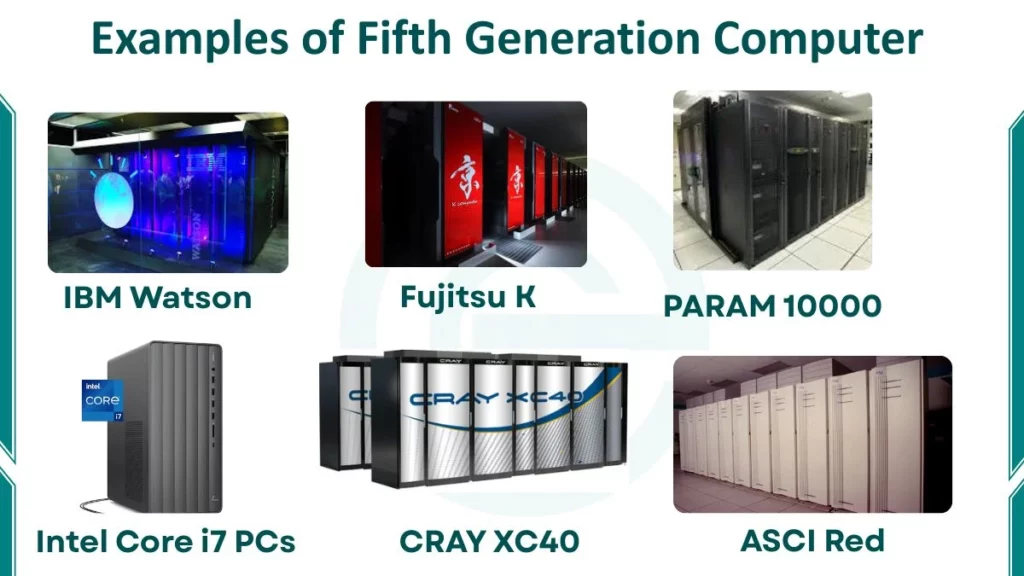Examples of Fifth Generation computers include IBM Watson, Fujitsu K, Deep Blue, NEC SX-5, PARAM 10000, Intel Core i7 PCs, CRAY XC40, ASCI Red, Google DeepMind, and Blue Gene.
Examples of Fifth Generation Computers have been developed from the 1990s to the present and represent the most advanced stage of computer evolution. They use artificial intelligence (AI), machine learning, parallel processing, and ultra-large-scale integration (ULSI) technology.

Fifth Generation of Computer Examples
The following is a list of examples of fifth generation computers:
- IBM Watson
- Fujitsu K
- Deep Blue
- NEC SX-5
- PARAM 10000
- Intel Core i7 PCs
- CRAY XC40
- ASCI Red
- Google DeepMind
- Blue Gene
Now, let’s discuss each example in detail.
1. IBM Watson
IBM Watson is one of the most popular AI-powered computers. It was developed by IBM (with research beginning around 2007). It is designed to understand natural language, analyze data, and make intelligent decisions. Watson gained global attention when it defeated human champions in the quiz show Jeopardy in 2011.
Features:
- Uses artificial intelligence and machine learning.
- Understands and processes natural human language.
- Analyzes massive datasets quickly.
- Uses cloud computing for scalability.
- Learns continuously from new data.
Purpose:
IBM Watson is used in healthcare, education, finance, and customer support to analyze data and provide intelligent recommendations.
Example Insight:
IBM Watson shows how AI can process human language and make logical decisions, marking a true milestone in intelligent computing.
2. Fujitsu K
Fujitsu K is a supercomputer developed by Fujitsu and RIKEN in Japan, completed in 2011. It is one of the world’s fastest supercomputers and represents the power of fifth-generation high-performance computing.
Features:
- Built with over 80,000 SPARC64 VIIIfx processors.
- Performs up to 10 petaflops (10 quadrillion calculations per second).
- Uses parallel and distributed processing.
- Energy-efficient architecture.
- Runs scientific and environmental simulations.
Purpose:
Fujitsu K is used for weather forecasting, disaster prevention, medical research, and global climate modeling.
Example Insight:
Fujitsu K proves how AI and advanced hardware can combine to solve complex real-world scientific problems.
3. Deep Blue
Deep Blue was developed by IBM in 1997. It is a specialized computer designed for chess-playing using artificial intelligence and parallel processing.
Features:
- Uses AI algorithms and custom VLSI chips.
- Can analyze 200 million positions per second.
- Operates on parallel computing architecture.
- Follows complex decision-making rules.
- Self-learning through stored strategies.
Purpose:
Deep Blue is designed to play chess at a world championship level and analyze game strategies.
Example Insight:
Deep Blue made history when it defeated world chess champion Garry Kasparov, showcasing the intelligence potential of computers.
4. NEC SX-5
NEC SX-5 is a vector supercomputer developed by NEC Corporation in 1998. It is known for high-speed numerical calculations and large data handling.
Features:
- Uses ultra-large-scale integration circuits (ULSI).
- Supports vector and parallel processing.
- High-speed data transfer and computation.
- Used for scientific, meteorological, and engineering research.
- Energy-efficient design for long operations.
Purpose:
NEC SX-5 is used in weather forecasting, physics simulations, and aerospace modeling.
Example Insight:
NEC SX-5 demonstrates how modern computers can process massive data sets for global scientific research.
5. PARAM 10000
PARAM 10000 is an Indian supercomputer developed in 1998 by the Centre for Development of Advanced Computing (C-DAC). It marks India’s advancement into high-performance computing.
Features:
- Uses scalable parallel architecture.
- Powered by microprocessors and ULSI technology.
- Processes data in teraflop speed range.
- Runs multiple applications simultaneously.
- Highly customizable for research and engineering tasks.
Purpose:
PARAM 10000 is used for scientific research, weather analysis, and industrial modeling in India and abroad.
Example Insight:
PARAM 10000 symbolizes India’s growth in supercomputing and innovation in advanced computer systems.
6. Intel Core i7 PCs
Intel Core i7 processors, launched by Intel in 2008, power millions of personal computers and laptops. They represent modern fifth-generation computing for everyday use.
Features:
- Uses multi-core microprocessor design.
- Supports AI-based features and hyper-threading.
- High-speed performance with turbo boost technology.
- Energy-efficient with integrated graphics.
- Compatible with advanced operating systems.
Purpose:
Core i7 PCs are used for gaming, design, education, business, and multimedia work.
Example Insight:
Intel Core i7 chips make powerful computing accessible to everyone, combining speed, intelligence, and energy efficiency.
7. CRAY XC40
CRAY XC40 is a supercomputer built by Cray Inc. in 2014. It is widely used for complex simulations and artificial intelligence research.
Features:
- Based on advanced parallel computing technology.
- Delivers performance up to hundreds of petaflops.
- Scalable architecture for large workloads.
- Energy-efficient design.
- Runs scientific, defense, and AI applications.
Purpose:
CRAY XC40 is used for climate research, space modeling, and machine learning tasks.
Example Insight:
CRAY XC40 sets new performance standards for modern supercomputers, combining speed and intelligence at an exceptional level.
8. ASCI Red
ASCI Red was introduced in 1996 by Intel for the U.S. Department of Energy. It was the first teraflop supercomputer. This computer is capable of one trillion calculations per second.
Features:
- Built with over 9,000 Intel Pentium Pro processors.
- Modular and scalable design.
- Uses parallel and distributed computing.
- High fault tolerance and reliability.
- Used for defense and nuclear simulations.
Purpose:
ASCI Red is used to simulate nuclear weapons and perform high-security defense research.
Example Insight:
ASCI Red becomes the first machine to cross the teraflop barrier, setting a record in computational history.
9. Google DeepMind
Google DeepMind, founded in 2010. It is an AI system capable of learning and decision-making through neural networks and reinforcement learning. It is owned by Google’s parent company, Alphabet Inc.
Features:
- Uses deep learning and neural network algorithms.
- Self-learns from experience without direct programming.
- Processes massive real-time data.
- Uses cloud computing infrastructure.
- Integrates with robotics and simulation environments.
Purpose:
DeepMind is used for AI research, healthcare solutions, and intelligent automation systems.
Example Insight:
DeepMind achieved global fame by defeating human champions in the board game Go, proving the potential of artificial intelligence.
10. Blue Gene
Blue Gene is a supercomputer series developed by IBM in the early 2000s. It is designed for highly complex scientific simulations and biological research.
Features:
- Uses thousands of processors for parallel processing.
- Ultra-large-scale integration circuits for speed.
- Energy-efficient design.
- Processes hundreds of trillions of calculations per second.
- Used for life sciences, physics, and chemistry.
Purpose:
Blue Gene is used in genome mapping, climate modeling, and nuclear physics research.
Example Insight:
Blue Gene becomes one of the most energy-efficient and powerful supercomputers. It is shaping the future of advanced research.
Also Read:
